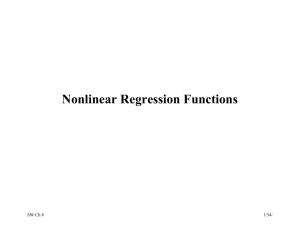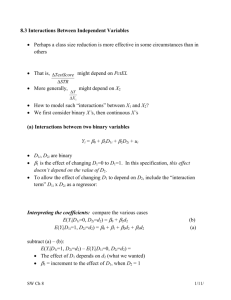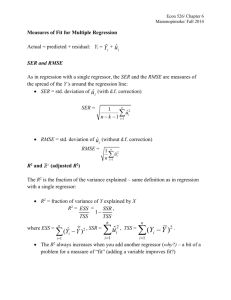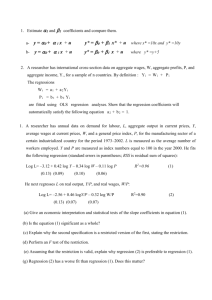Ch 6 Slides
advertisement
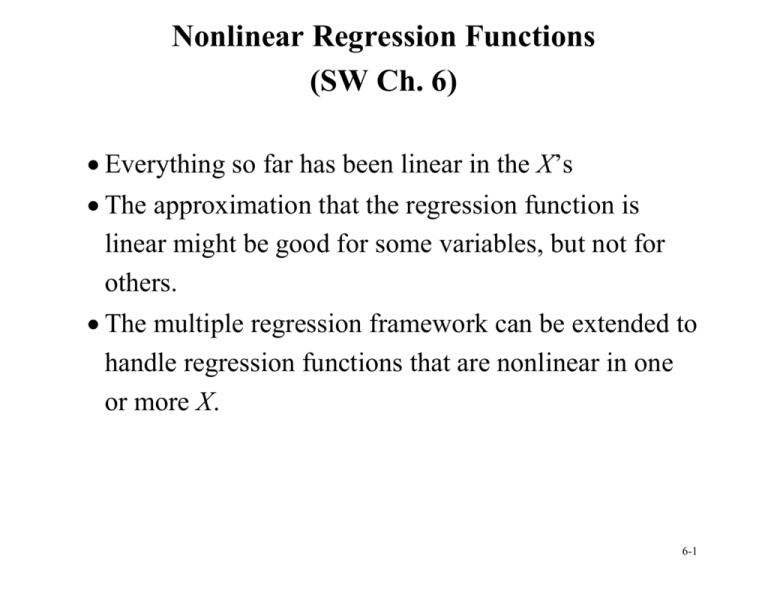
Nonlinear Regression Functions (SW Ch. 6) Everything so far has been linear in the X’s The approximation that the regression function is linear might be good for some variables, but not for others. The multiple regression framework can be extended to handle regression functions that are nonlinear in one or more X. 6-1 The TestScore – STR relation looks approximately linear… 6-2 But the TestScore – average district income relation looks like it is nonlinear. 6-3 If a relation between Y and X is nonlinear: The effect on Y of a change in X depends on the value of X – that is, the marginal effect of X is not constant A linear regression is mis-specified – the functional form is wrong The estimator of the effect on Y of X is biased – it needn’t even be right on average. The solution to this is to estimate a regression function that is nonlinear in X 6-4 The General Nonlinear Population Regression Function Yi = f(X1i,X2i,…,Xki) + ui, i = 1,…, n Assumptions 1. E(ui| X1i,X2i,…,Xki) = 0 (same); implies that f is the conditional expectation of Y given the X’s. 2. (X1i,…,Xki,Yi) are i.i.d. (same). 3. “enough” moments exist (same idea; the precise statement depends on specific f). 4. No perfect multicollinearity (same idea; the precise statement depends on the specific f). 6-5 6-6 Nonlinear Functions of a Single Independent Variable (SW Section 6.2) We’ll look at two complementary approaches: 1. Polynomials in X The population regression function is approximated by a quadratic, cubic, or higher-degree polynomial 2. Logarithmic transformations Y and/or X is transformed by taking its logarithm this gives a “percentages” interpretation that makes sense in many applications 6-7 1. Polynomials in X Approximate the population regression function by a polynomial: Yi = 0 + 1Xi + 2 X i2 +…+ r X ir + ui This is just the linear multiple regression model – except that the regressors are powers of X! Estimation, hypothesis testing, etc. proceeds as in the multiple regression model using OLS The coefficients are difficult to interpret, but the regression function itself is interpretable 6-8 Example: the TestScore – Income relation Incomei = average district income in the ith district (thousdand dollars per capita) Quadratic specification: TestScorei = 0 + 1Incomei + 2(Incomei)2 + ui Cubic specification: TestScorei = 0 + 1Incomei + 2(Incomei)2 + 3(Incomei)3 + ui 6-9 Estimation of the quadratic specification in STATA generate avginc2 = avginc*avginc; reg testscr avginc avginc2, r; Regression with robust standard errors Create a new regressor Number of obs F( 2, 417) Prob > F R-squared Root MSE = = = = = 420 428.52 0.0000 0.5562 12.724 -----------------------------------------------------------------------------| Robust testscr | Coef. Std. Err. t P>|t| [95% Conf. Interval] -------------+---------------------------------------------------------------avginc | 3.850995 .2680941 14.36 0.000 3.32401 4.377979 avginc2 | -.0423085 .0047803 -8.85 0.000 -.051705 -.0329119 _cons | 607.3017 2.901754 209.29 0.000 601.5978 613.0056 ------------------------------------------------------------------------------ The t-statistic on Income2 is -8.85, so the hypothesis of linearity is rejected against the quadratic alternative at the 1% significance level. 6-10 Interpreting the estimated regression function: (a) Plot the predicted values TestScore = 607.3 + 3.85Incomei – 0.0423(Incomei)2 (2.9) (0.27) (0.0048) 6-11 Interpreting the estimated regression function: (a) Compute “effects” for different values of X TestScore = 607.3 + 3.85Incomei – 0.0423(Incomei)2 (2.9) (0.27) (0.0048) Predicted change in TestScore for a change in income to $6,000 from $5,000 per capita: TestScore = 607.3 + 3.85 6 – 0.0423 62 – (607.3 + 3.85 5 – 0.0423 52) = 3.4 6-12 TestScore = 607.3 + 3.85Incomei – 0.0423(Incomei)2 Predicted “effects” for different values of X Change in Income (th$ per capita) TestScore from 5 to 6 from 25 to 26 from 45 to 46 3.4 1.7 0.0 The “effect” of a change in income is greater at low than high income levels (perhaps, a declining marginal benefit of an increase in school budgets?) Caution! What about a change from 65 to 66? Don’t extrapolate outside the range of the data. 6-13 Estimation of the cubic specification in STATA gen avginc3 = avginc*avginc2; reg testscr avginc avginc2 avginc3, r; Regression with robust standard errors Create the cubic regressor Number of obs F( 3, 416) Prob > F R-squared Root MSE = = = = = 420 270.18 0.0000 0.5584 12.707 -----------------------------------------------------------------------------| Robust testscr | Coef. Std. Err. t P>|t| [95% Conf. Interval] -------------+---------------------------------------------------------------avginc | 5.018677 .7073505 7.10 0.000 3.628251 6.409104 avginc2 | -.0958052 .0289537 -3.31 0.001 -.1527191 -.0388913 avginc3 | .0006855 .0003471 1.98 0.049 3.27e-06 .0013677 _cons | 600.079 5.102062 117.61 0.000 590.0499 610.108 ------------------------------------------------------------------------------ The cubic term is statistically significant at the 5%, but not 1%, level 6-14 Testing the null hypothesis of linearity, against the alternative that the population regression is quadratic and/or cubic, that is, it is a polynomial of degree up to 3: H0: pop’n coefficients on Income2 and Income3 = 0 H1: at least one of these coefficients is nonzero. test avginc2 avginc3; ( 1) ( 2) Execute the test command after running the regression avginc2 = 0.0 avginc3 = 0.0 F( 2, 416) = Prob > F = 37.69 0.0000 The hypothesis that the population regression is linear is rejected at the 1% significance level against the alternative that it is a polynomial of degree up to 3. 6-15 Summary: polynomial regression functions Yi = 0 + 1Xi + 2 X i2 +…+ r X ir + ui Estimation: by OLS after defining new regressors Coefficients have complicated interpretations To interpret the estimated regression function: o plot predicted values as a function of x o compute predicted Y/X at different values of x Hypotheses concerning degree r can be tested by tand F-tests on the appropriate (blocks of) variable(s). Choice of degree r o plot the data; t- and F-tests, check sensitivity of estimated effects; judgment. o Or use model selection criteria (maybe later) 6-16 2. Logarithmic functions of Y and/or X ln(X) = the natural logarithm of X Logarithmic transforms permit modeling relations in “percentage” terms (like elasticities), rather than linearly. Here’s why: x ln(x+x) – ln(x) = ln 1 x d ln( x ) 1 (calculus: ) dx x Numerically: ln(1.01) = .00995 .01; ln(1.10) = .0953 x x .10 (sort of) 6-17 Three cases: Case I. linear-log Population regression function II. log-linear ln(Yi) = 0 + 1Xi + ui III. log-log Yi = 0 + 1ln(Xi) + ui ln(Yi) = 0 + 1ln(Xi) + ui The interpretation of the slope coefficient differs in each case. The interpretation is found by applying the general “before and after” rule: “figure out the change in Y for a given change in X.” 6-18 I. Linear-log population regression function Now change X: Subtract (a) – (b): now so or Yi = 0 + 1ln(Xi) + ui (b) Y + Y = 0 + 1ln(X + X) (a) Y = 1[ln(X + X) – ln(X)] ln(X + X) – ln(X) X , X X Y 1 X Y 1 (small X) X / X 6-19 Linear-log case, continued Yi = 0 + 1ln(Xi) + ui for small X, 1 Y X / X X Now 100 = percentage change in X, so a 1% X increase in X (multiplying X by 1.01) is associated with a .011 change in Y. 6-20 Example: TestScore vs. ln(Income) First defining the new regressor, ln(Income) The model is now linear in ln(Income), so the linear-log model can be estimated by OLS: TestScore = 557.8 + 36.42 ln(Incomei) (3.8) (1.40) so a 1% increase in Income is associated with an increase in TestScore of 0.36 points on the test. Standard errors, confidence intervals, R2 – all the usual tools of regression apply here. How does this compare to the cubic model? 6-21 TestScore = 557.8 + 36.42 ln(Incomei) 6-22 II. Log-linear population regression function Now change X: Subtract (a) – (b): so or Y Y 1 ln(Yi) = 0 + 1Xi + ui (b) ln(Y + Y) = 0 + 1(X + X) (a) ln(Y + Y) – ln(Y) = 1X 1X Y / Y (small X) X 6-23 Log-linear case, continued ln(Yi) = 0 + 1Xi + ui for small X, 1 Y / Y X Y Now 100 = percentage change in Y, so a change Y in X by one unit (X = 1) is associated with a 1001% change in Y (Y increases by a factor of 1+1). Note: What are the units of ui and the SER? o fractional (proportional) deviations o for example, SER = .2 means… 6-24 III. Log-log population regression function Now change X: Subtract: ln(Yi) = 0 + 1ln(Xi) + ui (b) ln(Y + Y) = 0 + 1ln(X + X) (a) ln(Y + Y) – ln(Y) = 1[ln(X + X) – ln(X)] so Y Y or 1 X 1 X Y / Y (small X) X / X 6-25 Log-log case, continued ln(Yi) = 0 + 1ln(Xi) + ui for small X, 1 Y / Y X / X Y X Now 100 = percentage change in Y, and 100 = Y X percentage change in X, so a 1% change in X is associated with a 1% change in Y. In the log-log specification, 1 has the interpretation of an elasticity. 6-26 Example: ln( TestScore) vs. ln( Income) First defining a new dependent variable, ln(TestScore), and the new regressor, ln(Income) The model is now a linear regression of ln(TestScore) against ln(Income), which can be estimated by OLS: ln(TestScore) = 6.336 + 0.0554 ln(Incomei) (0.006) (0.0021) An 1% increase in Income is associated with an increase of .0554% in TestScore (factor of 1.0554) How does this compare to the log-linear model? 6-27 Neither specification seems to fit as well as the cubic or linear-log 6-28 Summary: Logarithmic transformations Three cases, differing in whether Y and/or X is transformed by taking logarithms. After creating the new variable(s) ln(Y) and/or ln(X), the regression is linear in the new variables and the coefficients can be estimated by OLS. Hypothesis tests and confidence intervals are now standard. The interpretation of 1 differs from case to case. Choice of specification should be guided by judgment (which interpretation makes the most sense in your application?), tests, and plotting predicted values 6-29 Interactions Between Independent Variables (SW Section 6.3) Perhaps a class size reduction is more effective in some circumstances than in others… Perhaps smaller classes help more if there are many English learners, who need individual attention TestScore That is, might depend on PctEL STR Y More generally, might depend on X2 X 1 How to model such “interactions” between X1 and X2? We first consider binary X’s, then continuous X’s 6-30 (a) Interactions between two binary variables Yi = 0 + 1D1i + 2D2i + ui D1i, D2i are binary 1 is the effect of changing D1=0 to D1=1. In this specification, this effect doesn’t depend on the value of D2. To allow the effect of changing D1 to depend on D2, include the “interaction term” D1i D2i as a regressor: Yi = 0 + 1D1i + 2D2i + 3(D1i D2i) + ui 6-31 Interpreting the coefficients Yi = 0 + 1D1i + 2D2i + 3(D1i D2i) + ui General rule: compare the various cases E(Yi|D1i=0, D2i=d2) = 0 + 2d2 (b) E(Yi|D1i=1, D2i=d2) = 0 + 1 + 2d2 + 3d2 (a) subtract (a) – (b): E(Yi|D1i=1, D2i=d2) – E(Yi|D1i=0, D2i=d2) = 1 + 3d2 The effect of D1 depends on d2 (what we wanted) 3 = increment to the effect of D1, when D2 = 1 6-32 Example: TestScore, STR, English learners Let 1 if STR 20 HiSTR = and HiEL = 0 if STR 20 1 if PctEL l0 0 if PctEL 10 TestScore = 664.1 – 18.2HiEL – 1.9HiSTR – 3.5(HiSTR HiEL) (1.4) (2.3) (1.9) (3.1) “Effect” of HiSTR when HiEL = 0 is –1.9 “Effect” of HiSTR when HiEL = 1 is –1.9 – 3.5 = –5.4 Class size reduction is estimated to have a bigger effect when the percent of English learners is large This interaction isn’t statistically significant: t = 3.5/3.1 6-33 (b) Interactions between continuous and binary variables Yi = 0 + 1Di + 2Xi + ui Di is binary, X is continuous As specified above, the effect on Y of X (holding constant D) = 2, which does not depend on D To allow the effect of X to depend on D, include the “interaction term” Di Xi as a regressor: Yi = 0 + 1Di + 2Xi + 3(Di Xi) + ui 6-34 Interpreting the coefficients Yi = 0 + 1Di + 2Xi + 3(Di Xi) + ui General rule: compare the various cases Y = 0 + 1D + 2X + 3(D X) (b) Now change X: Y + Y = 0 + 1D + 2(X+X) + 3[D (X+X)] subtract (a) – (b): (a) Y Y = 2X + 3DX or = 2 + 3D X The effect of X depends on D (what we wanted) 3 = increment to the effect of X, when D = 1 Example: TestScore, STR, HiEL (=1 if PctEL 20) 6-35 TestScore = 682.2 – 0.97STR + 5.6HiEL – 1.28(STR HiEL) (11.9) (0.59) (19.5) (0.97) When HiEL = 0: TestScore = 682.2 – 0.97STR When HiEL = 1, TestScore = 682.2 – 0.97STR + 5.6 – 1.28STR = 687.8 – 2.25STR Two regression lines: one for each HiSTR group. Class size reduction is estimated to have a larger effect when the percent of English learners is large. Example, ctd. 6-36 TestScore = 682.2 – 0.97STR + 5.6HiEL – 1.28(STR HiEL) (11.9) (0.59) (19.5) (0.97) Testing various hypotheses: The two regression lines have the same slope coefficient on STR HiEL is zero: t = –1.28/0.97 = –1.32 can’t reject the The two regression lines have the same intercept the coefficient on HiEL is zero: t = –5.6/19.5 = 0.29 can’t reject Example, ctd. TestScore = 682.2 – 0.97STR + 5.6HiEL – 1.28(STR HiEL), (11.9) (0.59) (19.5) (0.97) 6-37 Joint hypothesis that the two regression lines are the same population coefficient on HiEL = 0 and population coefficient on STR HiEL = 0: F = 89.94 (p-value < .001) !! Why do we reject the joint hypothesis but neither individual hypothesis? Consequence of high but imperfect multicollinearity: high correlation between HiEL and STR HiEL Binary-continuous interactions: the two regression lines Yi = 0 + 1Di + 2Xi + 3(Di Xi) + ui Observations with Di= 0 (the “D = 0” group): 6-38 Yi = 0 + 2Xi + ui Observations with Di= 1 (the “D = 1” group): Yi = 0 + 1 + 2Xi + 3Xi + ui = (0+1) + (2+3)Xi + ui 6-39 6-40 (c) Interactions between two continuous variables Yi = 0 + 1X1i + 2X2i + ui X1, X2 are continuous As specified, the effect of X1 doesn’t depend on X2 As specified, the effect of X2 doesn’t depend on X1 To allow the effect of X1 to depend on X2, include the “interaction term” X1i X2i as a regressor: Yi = 0 + 1X1i + 2X2i + 3(X1i X2i) + ui Coefficients in continuous-continuous interactions 6-41 Yi = 0 + 1X1i + 2X2i + 3(X1i X2i) + ui General rule: compare the various cases Y = 0 + 1X1 + 2X2 + 3(X1 X2) Now change X1: (b) Y+ Y = 0 + 1(X1+X1) + 2X2 + 3[(X1+X1) X2] (a) subtract (a) – (b): Y Y = 1X1 + 3X2X1 or = 2 + 3X2 X 1 The effect of X1 depends on X2 (what we wanted) 3 = increment to the effect of X1 from a unit change in X2 Example: TestScore, STR, PctEL 6-42 TestScore = 686.3 – 1.12STR – 0.67PctEL + .0012(STR PctEL), (11.8) (0.59) (0.37) (0.019) The estimated effect of class size reduction is nonlinear because the size of the effect itself depends on PctEL: TestScore = –1.12 + .0012PctEL STR TestScore PctEL STR 0 –1.12 20% –1.12+.0012 20 = –1.10 Example, ctd: hypothesis tests TestScore = 686.3 – 1.12STR – 0.67PctEL + .0012(STR PctEL), (11.8) (0.59) (0.37) (0.019) 6-43 Does population coefficient on STR PctEL = 0? t = .0012/.019 = .06 can’t reject null at 5% level Does population coefficient on STR = 0? t = –1.12/0.59 = –1.90 can’t reject null at 5% level Do the coefficients on both STR and STR PctEL = 0? F = 3.89 (p-value = .021) reject null at 5% level(!!) (Why? high but imperfect multicollinearity) 6-44 Application: Nonlinear Effects on Test Scores of the Student-Teacher Ratio (SW Section 6.4) Focus on two questions: 1. Are there nonlinear effects of class size reduction on test scores? (Does a reduction from 35 to 30 have same effect as a reduction from 20 to 15?) 2. Are there nonlinear interactions between PctEL and STR? (Are small classes more effective when there are many English learners?) 6-45 Strategy for Question #1 (different effects for different STR?) Estimate linear and nonlinear functions of STR, holding constant relevant demographic variables o PctEL o Income (remember the nonlinear TestScore-Income relation!) o LunchPCT (fraction on free/subsidized lunch) See whether adding the nonlinear terms makes an “economically important” quantitative difference (“economic” or “real-world” importance is different than statistically significant) Test for whether the nonlinear terms are significant 6-46 What is a good “base” specification? 6-47 The TestScore – Income relation An advantage of the logarithmic specification is that it is better behaved near the ends of the sample, especially large values of income. 6-48 Base specification From the scatterplots and preceding analysis, here are plausible starting points for the demographic control variables: Dependent variable: TestScore Independent variable PctEL LunchPCT Income Functional form linear linear ln(Income) (or could use cubic) 6-49 Question #1: Investigate by considering a polynomial in STR TestScore = 252.0 + 64.33STR – 3.42STR2 + .059STR3 (163.6) (24.86) (1.25) (.021) – 5.47HiEL – .420LunchPCT + 11.75ln(Income) (1.03) (.029) (1.78) Interpretation of coefficients on: HiEL? LunchPCT? ln(Income)? STR, STR2, STR3? 6-50 Interpreting the regression function via plots (preceding regression is labeled (5) in this figure) 6-51 Are the higher order terms in STR statistically significant? TestScore = 252.0 + 64.33STR – 3.42STR2 + .059STR3 (163.6) (24.86) (1.25) (.021) – 5.47HiEL – .420LunchPCT + 11.75ln(Income) (1.03) (.029) (1.78) (a) H0: quadratic in STR v. H1: cubic in STR? t = .059/.021 = 2.86 (p = .005) (b) H0: linear in STR v. H1: nonlinear/up to cubic in STR? F = 6.17 (p = .002) 6-52 Question #2: STR-PctEL interactions (to simplify things, ignore STR2, STR3 terms for now) TestScore = 653.6 – .53STR + 5.50HiEL – .58HiEL STR (9.9) (.34) (9.80) (.50) – .411LunchPCT + 12.12ln(Income) (.029) (1.80) Interpretation of coefficients on: STR? HiEL? (wrong sign?) HiEL STR? LunchPCT? ln(Income)? 6-53 Interpreting the regression functions via plots: TestScore = 653.6 – .53STR + 5.50HiEL – .58HiEL STR (9.9) (.34) (9.80) (.50) – .411LunchPCT + 12.12ln(Income) (.029) (1.80) “Real-world” (“policy” or “economic”) importance of the interaction term: TestScore = –.53 – .58HiEL = STR 1.12 if HiEL 1 .53 if HiEL 0 The difference in the estimated effect of reducing the STR is substantial; class size reduction is more effective in districts with more English learners 6-54 Is the interaction effect statistically significant? TestScore = 653.6 – .53STR + 5.50HiEL – .58HiEL STR (9.9) (.34) (9.80) (.50) – .411LunchPCT + 12.12ln(Income) (.029) (1.80) (a) H0: coeff. on interaction=0 v. H1: nonzero interaction t = –1.17 not significant at the 10% level (b) H0: both coeffs involving STR = 0 vs. H1: at least one coefficient is nonzero (STR enters) F = 5.92 (p = .003) Next: specifications with polynomials + interactions! 6-55 6-56 Interpreting the regression functions via plots: 6-57 Tests of joint hypotheses: 6-58 Summary: Nonlinear Regression Functions Using functions of the independent variables such as ln(X) or X1 X2, allows recasting a large family of nonlinear regression functions as multiple regression. Estimation and inference proceeds in the same way as in the linear multiple regression model. Interpretation of the coefficients is model-specific, but the general rule is to compute effects by comparing different cases (different value of the original X’s) Many nonlinear specifications are possible, so you must use judgment: What nonlinear effect you want to analyze? What makes sense in your application? 6-59
